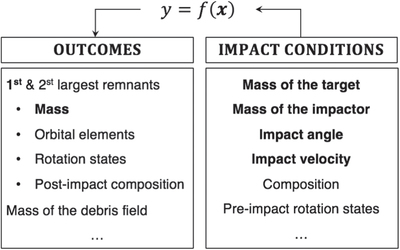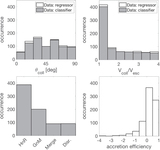Image Details

Caption: Figure 3.
A surrogate model (e.g., neural network) is able to generalize the functional relationship ﹩y=f({\boldsymbol{x}})﹩ between real-variable input ﹩{\boldsymbol{x}}﹩ (impact conditions, right column) and outputs y (collision outcomes, left column). Training occurs on N data of the type: {﹩{\boldsymbol{x}};﹩ y}i = {predictor; label}i, i = 1, …, N. Examples of impact conditions (predictors) and outcomes (labels) are shown in the right-hand and left-hand columns, respectively. In this pilot study, we train a neural network to associate four impact conditions (mass of the target, projectile-to-target mass ratio, impact angle, impact velocity) to accretion efficiency (or mass of the largest remnant, Equation (11)).
Copyright and Terms & Conditions
© 2019. The American Astronomical Society. All rights reserved.









